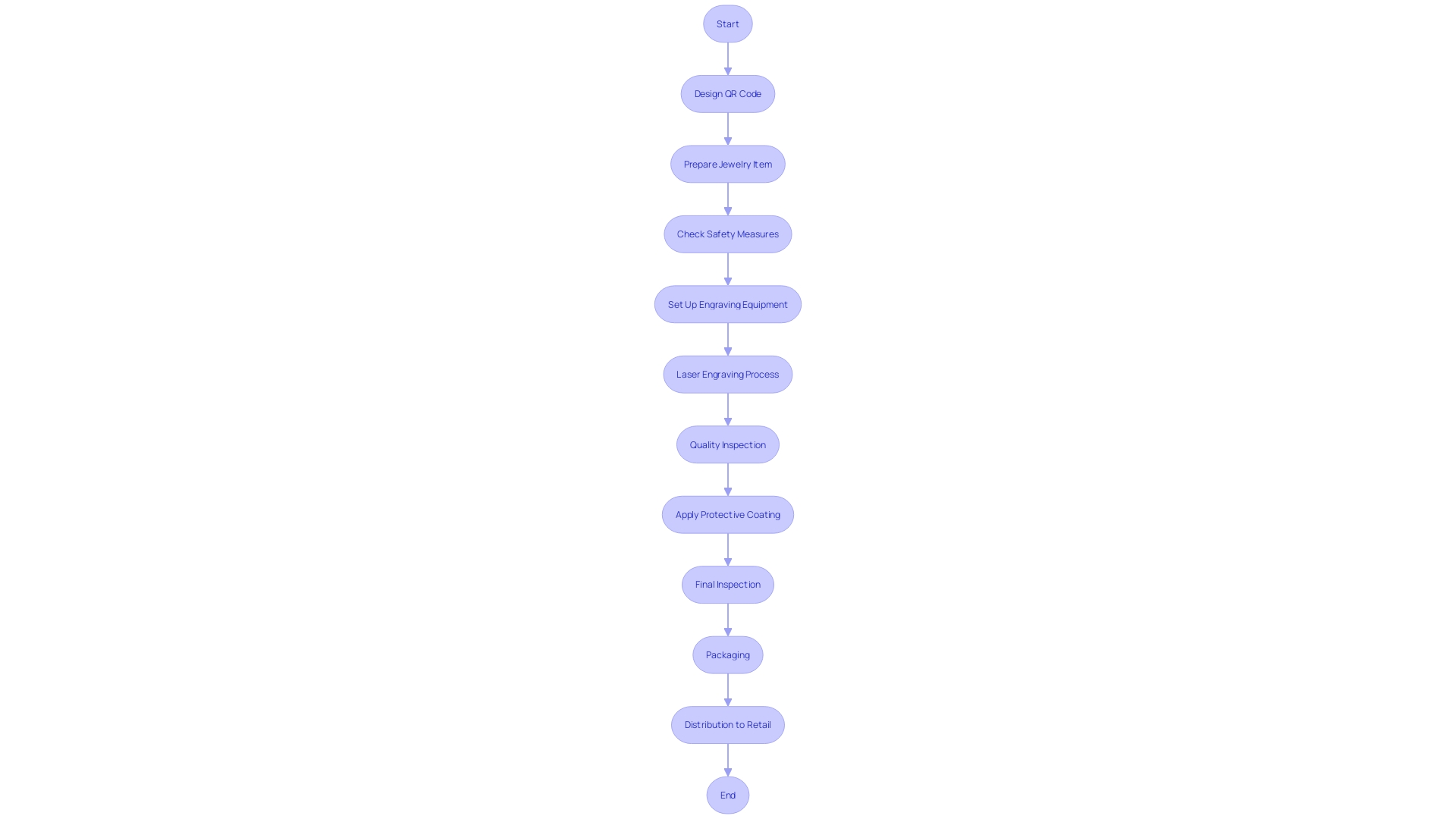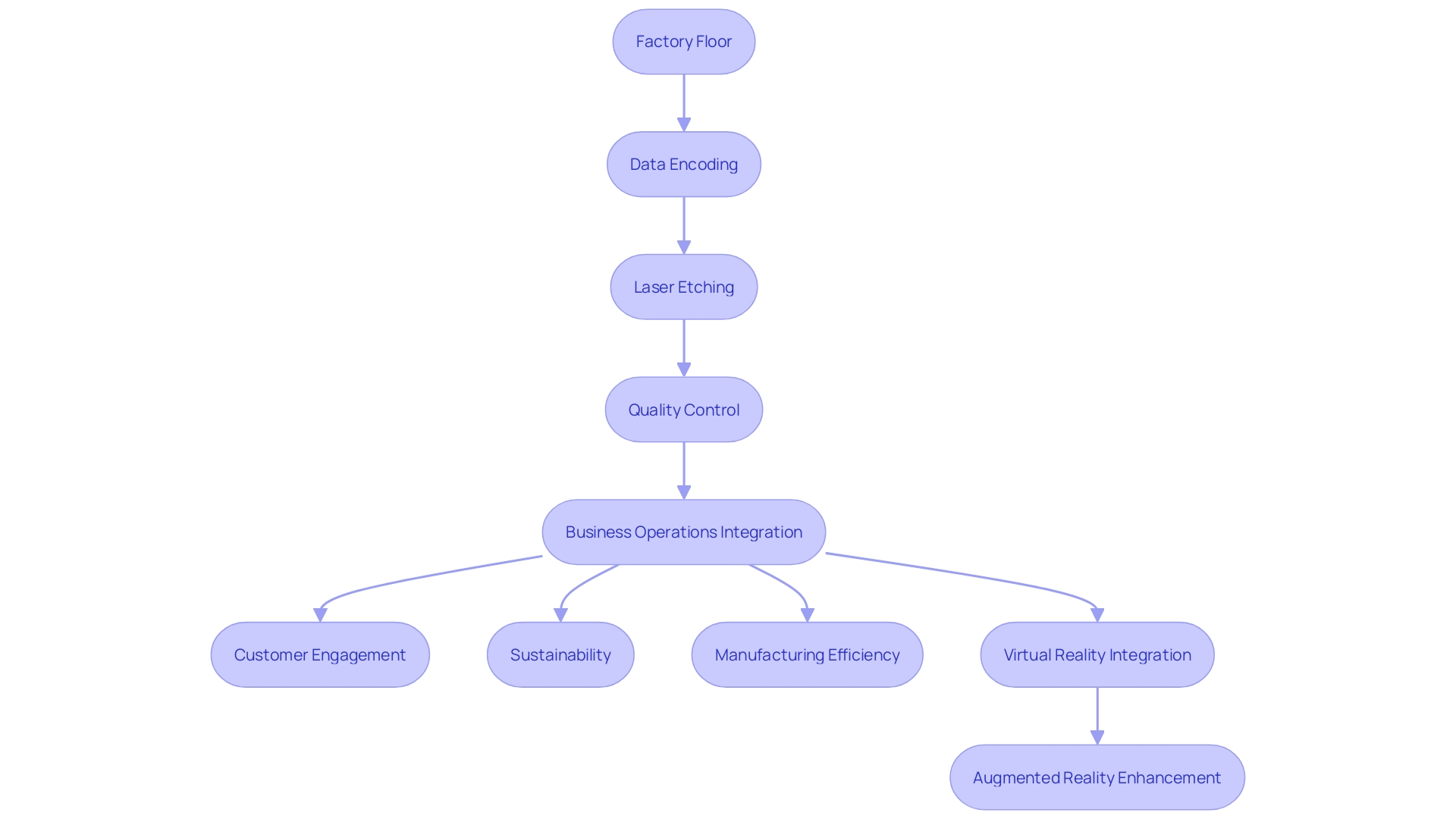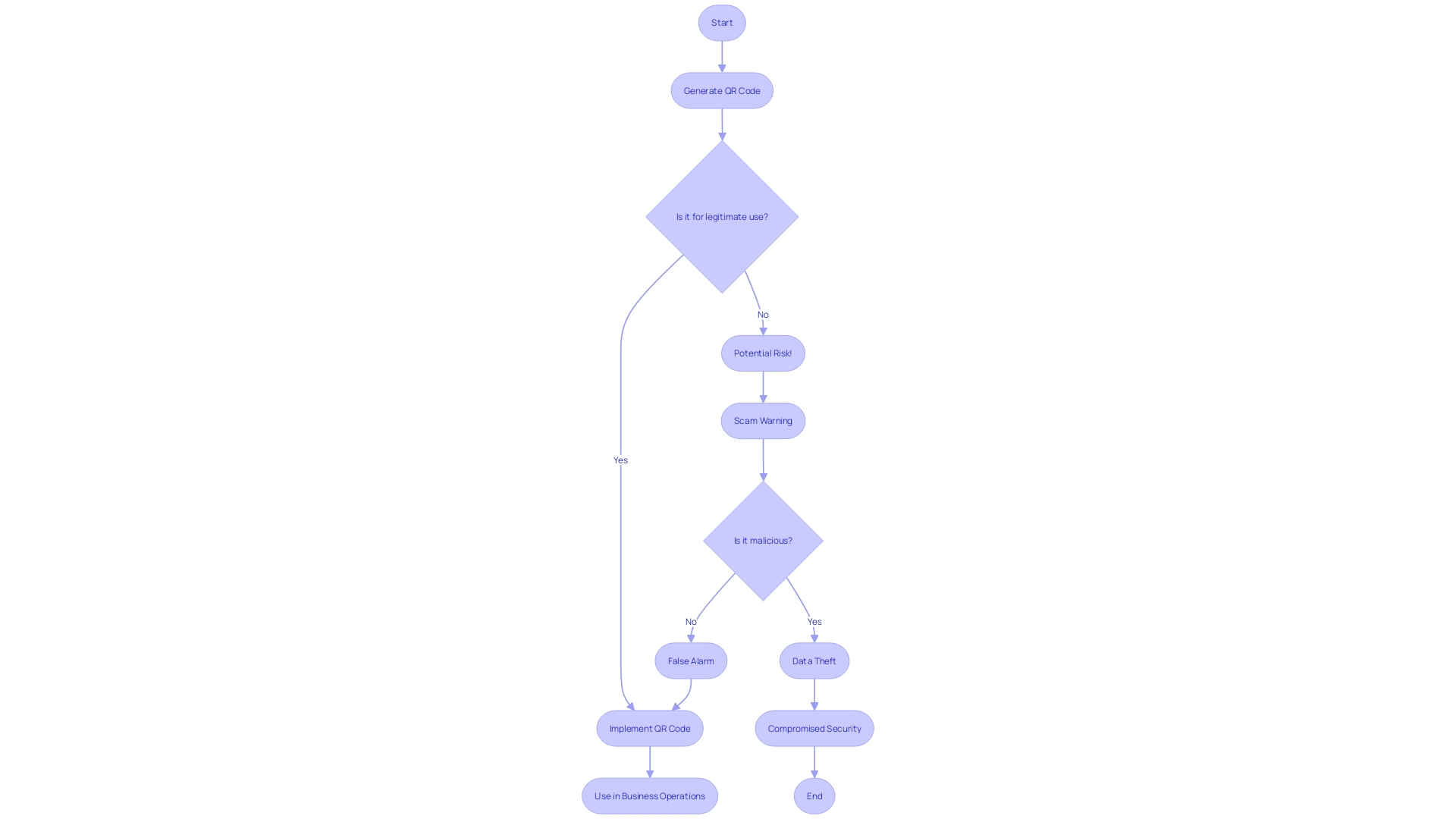Introduction
Laser QR code engraving has emerged as a crucial technology in the manufacturing industry, offering precision, efficiency, and versatility across various materials. With its ability to create permanent and tamper-proof marks, laser engraving is particularly valuable in industries where traceability and transparency are paramount, such as jewelry. Engraved QR codes provide a secure solution for verifying the provenance of products and meeting consumer demands for ethical sourcing.
The process of laser engraving QR codes requires advanced equipment and protective measures to ensure impeccable precision and safety. As the technology continues to evolve, its applications are expanding, with innovations like chemical analysis and unique fingerprint identification on the horizon. Companies like MB Metal Technologies are at the forefront of delivering cutting-edge marking solutions to meet the dynamic needs of diverse industries.
In this article, we will explore the importance of choosing the right laser engraver for QR code applications, setting up the engraver, configuring engraving parameters, achieving high-quality engravings, common applications of QR code laser engraving, and troubleshooting common issues that may arise during the engraving process. Let's dive into the world of laser QR code engraving and discover its transformative potential in the manufacturing landscape.
Understanding Laser Engraving Basics
Laser QR engraving has become a pivotal technology in today's manufacturing landscape, thanks to its precision, efficiency, and adaptability to a multitude of materials. It stands out in creating permanent, tamper-proof marks for traceability and identification purposes. The technology's superiority is amplified when used with QR codes, which act as portals to a plethora of information and are crucial in industries requiring high-level transparency, such as jewelry, where the origin of products is vital.
'Engraved QR symbols on items provide a secure resolution to the growing worry for ethical sourcing and verifiability.'. As Laurent Cartier of the Swiss Gemmological Institute notes, the jewelry industry's shift towards transparency is propelled by regulatory forces and consumer demand. Laser-engraved QR symbols, with their distinctive, unchangeable patterns, contribute to the traceability puzzle, allowing consumers to uncover the journey of their purchases from origin to retail.
To place QR codes using lasers, it is essential to prioritize safety and accuracy while incorporating safety measures and employing advanced equipment such as a robotic arm with four axes made of metal. Such technological advancements not only support ethical transparency but also enhance efficiency and productivity in various sectors.
As we anticipate the future, the significance of QR code etching using laser technology is bound to rise, with advancements such as the chemical examination of diamonds and the recognition of distinctive fingerprints leading the path for new applications. This evolving field aligns well with the vision of companies like MB Metal Technologies, which aid in delivering state-of-the-art marking solutions that cater to the dynamic needs of diverse industries.

Choosing the Right Laser Engraver for QR Code Engraving
Mastering the art of QR code etching with laser requires a deep understanding of the etching process and the right equipment to achieve the desired outcomes. To ensure that QR codes are not only aesthetically pleasing but also fully functional, choosing an engraving machine with the appropriate features and capabilities is essential.
With the fast pace of technological advancement, laser etching has solidified its position in the manufacturing industry, praised for its accuracy, effectiveness, and flexibility across a range of materials. This is exemplified by state-of-the-art equipment like the four-axis all-metal robotic arm, which ensures meticulous accuracy in the engraving process. When it comes to QR codes, this precision is non-negotiable as even the smallest deviation can render a code unreadable.
It is also vital to consider the types of materials you intend to engrave. Contemporary engravers that use advanced light technology are skilled at working with a wide range of materials, which is especially advantageous for projects that require customization, like individualized timepieces or distinctive products. For example, the Glowforge Aura, a consumer cutter designed for entry-level users, has shown remarkable proficiency in handling smaller projects with less powerful cutters.
Moreover, the importance of safety cannot be emphasized enough when operating machinery for marking. Adequate measures, including the use of protective eyewear and ensuring a well-ventilated workspace, are imperative to safeguard against accidents.
To summarize, when selecting a laser marking machine for QR applications, it's crucial to take into account the accuracy of the marking route, the versatility in working with various materials, and the safety protocols for operation. By doing this, you'll be well-prepared to create high-quality designs that meet both aesthetic and functional standards.
Setting Up Your Laser Engraver for QR Code Engraving
Configuring your laser engraver for QR code marking is not simply a matter of technical knowledge; it's about creating a gateway that seamlessly connects the physical and digital worlds. As the technology of using concentrated light beams to create detailed designs on surfaces carves its own place in the manufacturing industry with unmatched accuracy and flexibility, it is essential to prioritize safety and accuracy in the forefront of the procedure. Before diving into the setup, remember to don protective eyewear and ensure the presence of fire extinguishers and adequate ventilation in your workspace. The process of laser QR marking starts with comprehending the precise motion of a four-axis all-metal robot arm that directs the laser with impressive precision.
To optimize the potential of your engraving, consider utilizing advanced, user-friendly CAD software to create intricate QR designs. These tools are not only accessible but also free, empowering makers at all levels to bring their creative visions to life. Once your design is complete, utilize the opportunity to incorporate logos or reference images, enhancing the QR symbol with a personal touch that can boost scan rates by up to 30%.
As QR codes serve as a link between physical items and virtual experiences, they provide a seamless transition across different interaction channels. Whether it’s a parking meter or a smartphone app, the QR symbol stands as an icon of connectivity. By configuring your engraving machine with meticulousness and a touch of ingenuity, you empower these symbols to not only convey information but also symbolize your brand in the constantly changing digital environment.
Configuring Laser Engraving Parameters for QR Codes
Attaining accuracy in QR encoding with laser etching is not only about possessing the appropriate machinery; it's about comprehending and meticulously adjusting a collection of essential parameters. Each job involving the inscribing process requires a unique approach, taking into account the complexities of both the material being inscribed and the desired result. When etching QR codes, which must be scannable and clear, one must consider the laser's power, speed, and the cleanliness of the optics involved.
The depth and darkness of the marking is determined by the laser power. A rule of thumb is that higher power settings result in deeper engravings, which is essential for materials that might undergo post-processing or exposure to harsh conditions. However, this comes with a balance; too high power can lead to burnt edges or distorted codes.
Speed is another crucial factor; it determines how rapidly the light moves across the material. A higher velocity may result in more efficiency, but it can also cause shallower markings, which may not be easily legible. On the flip side, slower speeds can enhance the quality but increase the risk of burning the material.
The condition of the optics also plays a significant role. Ensuring that the lenses and mirrors are clean and undamaged guarantees the precision and quality of the laser's output. Regular maintenance and checks are therefore indispensable for consistent results.
The complexity of configuring these parameters is reflective of the technology's adaptability and the wide range of applications it supports, from intricate jewelry designs to robust industrial components. For example, progress in laser engraving has resulted in the creation of solutions such as the four-axis all-metal robotic arm, which improves accuracy in engraving paths, ensuring that each QR symbol is flawlessly rendered for its intended purpose.
In the luxury sector, QR symbols engraved on jewelry offer not just visual appeal but also a layer of security and traceability. These codes can store information about the gem's origin and history, responding to consumers' growing demands for transparency in the supply chains of luxury goods.
As we enter the world of nanotechnology and quantum dots, the possibilities of using lasers for etching expand even more. The ability to fine-tune optical properties of materials at the quantum level illustrates the level of detail that can be achieved with the right settings.
In practice, preparing for the use of marking with a laser requires more than just technical knowledge. It's about creating a safe and conducive environment with appropriate safety measures like protective eyewear and fire extinguishers, ensuring the well-being of the operator and the quality of the work.
In the end, the objective is not simply to etch a QR symbol but to achieve this in a manner that the final outcome is both useful and in accordance with regulations such as the FDA's UDI, which requires the ability to track medical devices. By capturing full, timely, and accurate consumption data, healthcare providers can meet these regulatory demands, demonstrating the critical role of laser marking in modern supply chain management.
Tips for Achieving High-Quality QR Code Engraving
Achieving high-quality QR engravings that are both clear and durable involves leveraging sophisticated technologies and adhering to best practices. For instance, Taqtile, Inc. has enhanced its Manifest Maker app, which now allows for the creation of detailed digital work instructions. This type of innovation simplifies the incorporation of QR codes in different applications, guaranteeing they are not only precise but also easy to use.
In the world of augmented and mixed reality, one must start from reality to guide the design process. Likewise, when etching QR symbols, it is crucial to take into account the physical characteristics of the substance and the intended application to guarantee optimal readability and performance. This is exemplified by the research conducted in the Department of Chemistry, where high-resolution images were produced in polymers, demonstrating the precision achievable with current technology.
Moreover, with more than 10 million users participating in VR games like Gorilla Tag, the landscape is rapidly expanding. QR codes function as a bridge connecting the physical and digital realms, offering users immediate access to digital services, as seen in the instance where scanning a QR code immediately provided comprehensive data and documentation.
Furthermore, the most recent market research suite offers a comprehensive overview of the QR payments market, emphasizing the importance of QR technology across industries. As QR symbols become more and more essential to user experience, it is vital to produce inscriptions that fulfill the utmost criteria of transparency and sustainability, therefore optimizing their efficiency in today's digitally-driven setting.
Common Applications of QR Code Laser Engraving
QR laser engraving is transforming the way industries operate, streamlining processes from the factory floor to the end consumer. These versatile symbols, which originated in Japan in 1994, have become essential in connecting the divide between the physical and virtual worlds, providing a seamless method for information exchange and interaction. Having the capacity to save URLs, text data, and various other information, QR codes are not only a contemporary convenience; they play a crucial role in today's technological infrastructure.
Industries are utilizing the power of QR symbols to enhance customer engagement by providing quick access to digital content. From the recycled paper industry, which views QR codes as a tool for promoting sustainability and tracking products, to the high-precision demands of modern manufacturing where QR code laser etching guarantees accuracy and efficiency, the impact is profound. These engravings offer unparalleled advantages in terms of precision, adaptability to different materials, and operational efficiency.
The incorporation of QR symbols into business operations goes beyond traditional marketing, streamlining transactions and customer interactions. As factories embrace Ultra-Wideband (UWB) technology for precise positioning of products, QR codes supplement this by offering convenient access to virtual models and improving safety measures. In a world where virtual reality (VR) is set to become commonplace, QR symbols are anticipated to become an integral part of the digital realm, further cementing their ubiquitous presence across industries.
The future of QR technology promises even greater integration into our daily lives, as these symbols evolve from being seen as novel innovations to becoming standard practice. As we look ahead, the ongoing acceptance and progression of QR laser engraving will undoubtedly shape the landscape of industry and commerce, offering a glimpse into the endless possibilities of a connected world.

Troubleshooting Common Issues in QR Code Engraving
Generating QR codes is a piece of cake with the readily accessible and user-friendly tools at our disposal. Similar to scanning them, creating your own QR can be accomplished in just a few steps. Nevertheless, individuals should be cautious that QR codes can serve as an entry point to harmful websites if not meticulously designed and verified. For example, a seemingly innocent QR symbol stuck on a wall or attached to an email could direct unsuspecting individuals to sites designed to compromise security or steal login credentials. These concerns are not to be taken lightly, as smooth transitions from physical to virtual spaces—such as downloading a parking meter application or sharing electronic business cards—rely on the integrity of these symbols. With a wide range of personalization choices, QR codes have become a fundamental element in efficiently sharing information, from the origins of farm produce to contact details, as demonstrated by Tracy Whelpley, Sr. Vice President, who praises the prompt resolution of functionality issues, emphasizing the importance of user-friendly support in QR solutions. Furthermore, as we incorporate technologies like augmented reality into digital work instructions, enhancements to applications such as Taqtile's Manifest Maker for the iPad showcase the continuous development of digital asset libraries, further integrating QR codes into operational workflows. Despite these advancements, users must remain vigilant against QR scams that exploit the technology for deceitful purposes, from fake delivery notices to fraudulent account security alerts. Therefore, when issues arise during QR code engraving, it's crucial to have a comprehensive understanding of both the technology's potential and its pitfalls to troubleshoot effectively.

Conclusion
In conclusion, laser QR code engraving is a pivotal technology in manufacturing, offering precision, efficiency, and versatility. Choosing the right engraver, setting up properly, and configuring parameters are crucial for high-quality engravings. QR codes have diverse applications, enhancing customer engagement and streamlining processes across industries.
However, vigilance is necessary to protect against potential security risks. With continued advancements, QR code technology will further integrate into our daily lives, shaping the landscape of industry and commerce.




